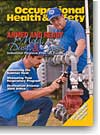
May 2004
Cover Story
By Bruce Holcom
TODAY there are a variety of sensors used to detect flammable gases. There are also many different flammable conditions, each requiring a specific type of sensor to be accurately measured.
Features
By Walt Swietlik
SAFETY managers are leaving no stone unturned when it comes to security, which is why more and more decision-makers are taking another look at the loading dock.
By Steve Freedman
YOU must start thinking safety early. One of the most frequent mistakes system designers make is thinking only of the production process and ignoring the fact that the system will be safeguarded later to prevent injury, before it is put into productive use.
By Robert A. Ernst
MOLD problems and reports of suspected mold-related illness and injury are quickly becoming a health issue for many safety professionals. When excessive moisture accumulates indoors, mold growth often occurs, bringing with it health complaints ranging from asthma to severe allergic reactions.
By Bob Henderson
THE North American multi-sensor gas detector market is very large. Most of these instruments are purchased, at least in part, for use in confined space entry programs.
By Kimberly Dennis
CHOOSING the best chemical protection garment can be complicated. An ideal garment for one situation may be too much or too little protection in different conditions. However, by assessing workplace risks and applying the right evaluation methods, the garment selection process becomes less complicated.
By Dave D. Wagner
INDUSTRIAL hygiene gas surveys play a key role in helping industrial hygienists evaluate and determine whether workers are being exposed to hazardous conditions within their workplace environment. Portable gas monitoring instruments can be a valuable tool used in these surveys to provide data that is vital to the success of the mission.
By Fred Elliott
WE'RE entering the season when OSHA wants employers to pay special attention to heat-related illnesses. Managers should know the symptoms and take quick action when heat-related problems occur.
By Dale M. Petroff
A risk communication strategy is an important component of the response to any event. Risk communication has two major components: hazard communications to emergency responders and to the public.
By Ken Vaughan
ASSESSING your company's respiratory protection program is serious business. In some instances, it may mean the difference between life and death.
By Heather Walrod, Mike Dalton
CANCER, disease, famine . . . all are proven killers. However, many people are unaware there is a silent killer on the loose that can be just as deadly as any disease if not properly monitored. Many times, this predator is not taken as seriously as it should be, and thus the chances rise that employees will be caught by this looming problem.
By Mike Stearns
WHEN OSHA's revised Respiratory Protection Standard for General Industry, 29 CFR 1910.134, became effective on April 8, 1998, it provided employers with an all-inclusive reference source for fit testing guidelines.
By Casey Hayes
WHEN we were kids, a game of "tag" always had a "home base" or a safe zone, where the unfortunate player who was "it" couldn't get to us.
Departments
By Jerry Laws
PRIME paving season is here for much of the United States, causing highway work zones to sprout and renewing efforts to spread the gospel of safety to workers and motorists alike.
By Linda Keefe
IN any company, communication between managers and employees is a big issue. Employees want guidelines from their supervisors, and the management staffers want input from their team.
By Pete Tormey
AFFORDABLE Palm computers and software have given rise to a new family of tools for reducing paperwork and automating safety and other routine inspections. As with most new tools, the major advantage is reducing labor costs and saving administrative time, however, automating your inspection process can mean more than simply saving money.